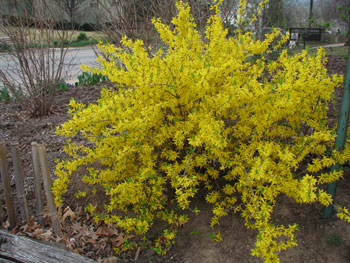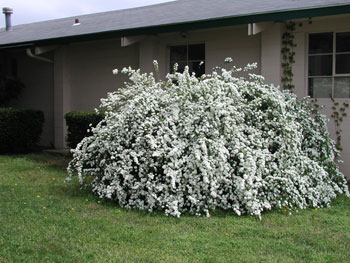Resource Library
Plant of the Week: Spirea (Deciduous Shrubs, Forsythia ‘Tidal wave’ )
The University of Arkansas System Division of Agriculture does not promote, support or recommend plants featured in "Plant of the Week." Please consult your local Extension office for plants suitable for your region.
Plant of the Week
Forsythia ‘Tidal wave’ (Deciduous Shrubs)
Latin: Spiraea vanhouttei

Deciduous shrubs have fallen from fashion in gardening, being replaced by plants perceived as having more year-round interest. I consider this a mistake because some of the old-fashioned deciduous shrubs are among the most useful garden plants. Sure they only bloom a couple weeks during the year, but a big part of the joy of gardening is found in anticipation of a coming event, not the event itself. Let us consider some of the merits of the old-fashioned deciduous shrubs.
A century ago, deciduous shrubs – stalwarts such as flowering quince, forsythia, the spireas, mock orange, pearl bush, beauty bush, and a host of others – were the darlings of garden design. Part of their appeal was that they were new to the markets and gardeners were just getting to know these plants. Most of the plants listed above were introduced to gardeners between 1880 and 1910. A frailty of the human condition is our eagerness to embrace anything new.
Part of the reason they remained popular until after WWII was that they were the only kinds of plants readily available in the nursery trade. Up until that time, the center of nursery production was around the Great Lakes and in Iowa. Those regions have cold winters, mostly zone 5, so hardy deciduous shrubs fit in nicely with their climates. Also, because they could be dug and shipped bare root, distribution to customers throughout the country was more economical. Then as now, for a plant to be propagated in really large numbers, it must be adapted to a large swath of the country where most of the people live. The deciduous shrubs – in one form or another – are adapted to where about 90 percent of the U.S. population lives.

After WWII and the construction of the Interstate Highway system, nursery production moved south and west and plants began to appear in containers, making the sale of evergreens easier. These new evergreens – hollies, azaleas, boxwoods, junipers, yews and the like – displaced deciduous shrubs as the post-War building boom swept across the nation. Deciduous shrubs became dated and fell from favor.
But an all-evergreen landscape is not without its faults. Such landscapes often look the same in January and July and they lose the appeal of seasonal interest. Mix a few deciduous shrubs into the planting and suddenly you develop a rhythm that speaks of seasonal change and anticipation of something different happening each month.
One of the criticisms – and justly so – is that many of the deciduous shrubs are too large for the contemporary landscape. As a group the deciduous shrubs are easy to maintain at a predetermined size by timely and judicious pruning. As a rule they should be pruned back hard just after they finish flowering. Severe pruning is not usually needed every year but if it is delayed too long between pruning cycles, the plants can become pretty large. Remember the old saw when pruning – “prune till you think you have killed it, then prune some more.” Spireas and quince are on the smallish end and need less pruning while forsythia and beautybush are on the larger end and need more pruning.
If size frightens you, consider seeking out some of the newer, more dwarf forms of deciduous shrubs. A series of dwarf forsythia, the Showoff series, is now appearing in nurseries and offer the promise of three foot tall shrubs that bloom prolifically unlike some of the older dwarf forsythia offerings. Spireas can be had in a size range from 8-inch tall dwarfs up to 6-foot tall billowy shrubs. Deutzia is another dwarf shrub seldom seen over three feet tall.
Deciduous shrubs have a well-deserved reputation for being easy to grow. They are adaptable to any reasonable garden soil and, once established, have considerable drought tolerance. Most flower profusely only when planted in an area receiving at least six hours of direct sunlight. Most of these tough old veterans of the garden are resistant to pests and diseases. So I ask, what’s not to love about these old fashioned garden shrubs?
By: Gerald Klingaman, retired
Retired Extension Horticulturist - Ornamentals
Extension News - April 26, 2013
The University of Arkansas System Division of Agriculture does not maintain lists of retail outlets where these plants can be purchased. Please check your local nursery or other retail outlets to ask about the availability of these plants for your growing area.